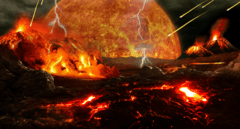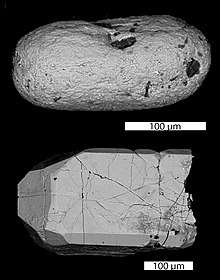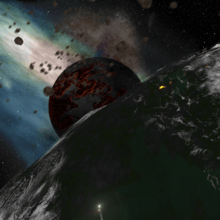Hadean
The Hadean ( /ˈheɪdiən, heɪˈdiːən/ HAY-dee-ən, hay-DEE-ən) is a geologic eon of the Earth pre-dating the Archean. It began with the formation of the Earth about 4.6 billion years ago and ended, as defined by the International Commission on Stratigraphy (ICS), 4 billion years ago.[1] As of 2016, the ICS describes its status as "informal".[2] Geologist Preston Cloud coined the term in 1972, originally to label the period before the earliest-known rocks on Earth.[3][4] W. Brian Harland later coined an almost synonymous term, the "Priscoan period", from priscus, the Latin word for 'ancient'.[5] Other, older texts refer to the eon as the Pre-Archean.[6][7]
| Hadean Eon 4600–4000 million years ago | |
 Artist's impression of a Hadean landscape | |
Etymology


"Hadean" (from Hades, the Greek god of the underworld, and the underworld itself) describes the hellish conditions then prevailing on Earth: the planet had just formed and was still very hot owing to its recent accretion, the abundance of short-lived radioactive elements, and frequent collisions with other Solar System bodies.
Subdivisions
Since few geological traces of this eon remain on Earth, there is no official subdivision. However, the Lunar geologic timescale embraces several major divisions relating to the Hadean, so these are sometimes used in an informal sense to refer to the same periods of time on Earth.
The Lunar divisions are:
- Pre-Nectarian, from the formation of the Moon's crust (4,533 million years ago) up to about 3,920 million years ago.
- Nectarian ranging from 3,920 million years ago up to about 3,850 million years ago, in a time when the Late Heavy Bombardment, according to that theory, was declining.
In 2010, an alternative scale was proposed that includes the addition of the Chaotian and Prenephelean Eons preceding the Hadean, and divides the Hadean into three eras with two periods each. The Paleohadean era consists of the Hephaestean (4.5–4.4 Ga) and the Jacobian periods (4.4–4.3 Ga). The Mesohadean is divided into the Canadian (4.3–4.2 Ga) and the Procrustean periods (4.2–4.1 Ga). The Neohadean is divided into the Acastan (4.1–4.0 Ga) and the Promethean periods (4.0–3.9 Ga).[8] As of February 2017, this has not been adopted by the IUGS.
Hadean rocks
In the last decades of the 20th century geologists identified a few Hadean rocks from western Greenland, northwestern Canada, and Western Australia. In 2015, traces of carbon minerals interpreted as "remains of biotic life" were found in 4.1-billion-year-old rocks in Western Australia.[9][10]
The oldest dated zircon crystals, enclosed in a metamorphosed sandstone conglomerate in the Jack Hills of the Narryer Gneiss Terrane of Western Australia, date to 4.404 ± 0.008 Ga.[11] This zircon is a slight outlier, with the oldest consistently-dated zircon falling closer to 4.35 Ga[11]—around 200 million years after the hypothesized time of the Earth's formation.
In many other areas, xenocryst (or relict) Hadean zircons enclosed in older rocks indicate that younger rocks have formed on older terranes and have incorporated some of the older material. One example occurs in the Guiana shield from the Iwokrama Formation of southern Guyana where zircon cores have been dated at 4.22 Ga.[12]
Atmosphere and oceans
A sizable quantity of water would have been in the material that formed the Earth.[13] Water molecules would have escaped Earth's gravity more easily when it was less massive during its formation. Hydrogen and helium are expected to continually escape (even to the present day) due to atmospheric escape.
Part of the ancient planet is theorized to have been disrupted by the impact that created the Moon, which should have caused melting of one or two large regions of the Earth. Earth's present composition suggests that there was not complete remelting as it is difficult to completely melt and mix huge rock masses.[14] However, a fair fraction of material should have been vaporized by this impact, creating a rock vapor atmosphere around the young planet. The rock vapor would have condensed within two thousand years, leaving behind hot volatiles which probably resulted in a heavy CO
2 atmosphere with hydrogen and water vapor. Liquid water oceans existed despite the surface temperature of 230 °C (446 °F) because at an atmospheric pressure of above 27 atmospheres, caused by the heavy CO
2 atmosphere, water is still liquid. As cooling continued, subduction and dissolving in ocean water removed most CO
2 from the atmosphere but levels oscillated wildly as new surface and mantle cycles appeared.[15]
Studies of zircons have found that liquid water must have existed as long ago as 4.4 billion years ago, very soon after the formation of the Earth.[16] This requires the presence of an atmosphere. The cool early Earth theory covers a range from about 4.4 to about 4.1 billion years.
A September 2008 study of zircons found that Australian Hadean rock holds minerals pointing to the existence of plate tectonics as early as 4 billion years ago (approximately 600 million years after Earth's formation).[17][18] If this is true, the time when Earth finished its transition from having a hot, molten surface and atmosphere full of carbon dioxide, to being very much like it is today, can be roughly dated to about 4.0 billion years ago. The actions of plate tectonics and the oceans trapped vast amounts of carbon dioxide, thereby reducing the greenhouse effect and leading to a much cooler surface temperature and the formation of solid rock, and possibly even life.[17][18]
See also
- Chaotian (geology) – Proposed era of, or eon preceding, the Hadean eon
- Formation and evolution of the Solar System – Formation of the Solar System by gravitational collapse of a molecular cloud and subsequent geological history
- Hadean zircon – The oldest-surviving crustal material from the Earth's earliest geological time period
- History of Earth – The development of planet Earth from its formation to the present day – the first sections describe the formation of the Earth
- Oldest dated rocks – Includes rocks over 4 billion years old from the Hadean Eon
- Precambrian – The earliest part of Earth's history: 4600–541 million years ago
- Timeline of natural history
References
- "International Chronostratigraphic Chart". International Commission on Stratigraphy. Retrieved 22 July 2020.
- Ogg, J. G.; Ogg, G.; Gradstein, F. M. (2016). A Concise Geologic Time Scale: 2016. Elsevier. p. 20. ISBN 978-0-444-63771-0.
- Cloud, Preston (1972). "A working model of the primitive Earth". American Journal of Science. 272 (6): 537–548. Bibcode:1972AmJS..272..537C. doi:10.2475/ajs.272.6.537.
- Bleeker, W. (2004). "10. Toward a "natural" Precambrian time scale". In Gradstein, Felix M.; Ogg, James G.; Smith, Alan G. (eds.). A Geologic Time Scale 2004. Cambridge, England, UK: Cambridge University Press. p. 145.
- Oxford Dictionary, "Priscoan"
- Shaw, D.M. (1975). "Early History of the Earth". Proceedings of the NATO Advanced Study Institute. Leicester: John Wiley (London): 33–53.
- Jarvis, Gary T.; Campbell, Ian H. (December 1983). "Archean komatiites and geotherms: Solution to an apparent contradiction". Geophysical Research Letters. 10 (12): 1133–1136. doi:10.1029/GL010i012p01133.
- "The eons of Chaos and Hades" (PDF). Solid Earth. 26 January 2010.
- Borenstein, Seth (19 October 2015). "Hints of life on what was thought to be desolate early Earth". Excite. Yonkers, NY: Mindspark Interactive Network. Associated Press. Retrieved 2015-10-20.
- Bell, Elizabeth A.; Boehnike, Patrick; Harrison, T. Mark; et al. (19 October 2015). "Potentially biogenic carbon preserved in a 4.1 billion-year-old zircon" (PDF). Proc. Natl. Acad. Sci. U.S.A. Washington, D.C.: National Academy of Sciences. 112: 14518–21. Bibcode:2015PNAS..11214518B. doi:10.1073/pnas.1517557112. ISSN 1091-6490. PMC 4664351. PMID 26483481. Retrieved 2015-10-20.
- Wilde, Simon A.; Valley, John W.; Peck, William H.; Graham, Colin M. (2001). "Evidence from detrital zircons for the existence of continental crust and oceans on the Earth 4.4 Gyr ago". Nature. 409 (6817): 175–178. Bibcode:2001Natur.409..175W. doi:10.1038/35051550. PMID 11196637.
- Nadeau, Serge; Chen, Wei; Reece, Jimmy; Lachhman, Deokumar; Ault, Randy; Faraco, Maria; Fraga, Leda; Reis, Nelson; Betiollo, Leandro (2013-12-01). "Guyana: the Lost Hadean crust of South America?". Brazilian Journal of Geology. 43: 601–606. doi:10.5327/Z2317-48892013000400002.
- Drake, Michael J. (2005), "Origin of water in the terrestrial planets" (PDF), Meteoritics & Planetary Science, 40 (4): 515–656, Bibcode:2005M&PS...40..515J, doi:10.1111/j.1945-5100.2005.tb00958.x, archived from the original (PDF) on 2011-10-09.
- Taylor, G. Jeffrey. "Origin of the Earth and Moon". Solar System Exploration. NASA. Archived from the original on March 8, 2015.
- Sleep, N. H.; Zahnle, K.; Neuhoff, P. S. (2001), "Initiation of clement surface conditions on the earliest Earth", PNAS, 98 (7): 3666–3672, Bibcode:2001PNAS...98.3666S, doi:10.1073/pnas.071045698, PMC 31109, PMID 11259665.
- "Hell's milder side". Research School of Earth Sciences. Australian National University. Archived from the original on 2006-06-21.
"There was no such thing as hell on Earth". Media Release: Marketing & Communications. Australian National University. 18 November 2005. Archived from the original on 8 February 2006.
Valley, John W.; Peck, William H.; King, Elizabeth M.; Wilde, Simon A. (April 2002). "A Cool Early Earth". Geology. 30 (4): 351–354. Bibcode:2002Geo....30..351V. doi:10.1130/0091-7613(2002)030<0351:ACEE>2.0.CO;2. - Chang, Kenneth (December 2, 2008). "A New Picture of the Early Earth". The New York Times.
- Abramov, Oleg; Mojzsis, Stephen J. (December 2008). "Thermal State of the Lithosphere During Late Heavy Bombardment: Implications for Early Life". AGU Fall Meeting Abstracts. Fall Meeting 2008: American Geophysical Union. 1 (2008 Fall Meeting). Bibcode:2008AGUFM.V11E..08A.CS1 maint: location (link)
Further reading
- Hopkins, Michelle; Harrison, T. Mark; Manning, Craig E. (2008), "Low heat flow inferred from >4 Gyr zircons suggests Hadean plate boundary interactions", Nature, 456 (7221): 493–496, Bibcode:2008Natur.456..493H, doi:10.1038/nature07465, PMID 19037314.
- Valley, John W.; Peck, William H.; King, Elizabeth M. (1999), "Zircons Are Forever", The Outcrop for 1999, University of Wisconsin-Madison, retrieved January 10, 2006 – Evidence from detrital zircons for the existence of continental crust and oceans on the Earth 4.4 Gyr ago.
- Wilde, S. A.; Valley, J. W.; Peck, W. H. & Graham, C. M. (2001), "Evidence from detrital zircons for the existence of continental crust and oceans on the Earth 4.4 Gyr ago", Nature, 409 (6817): 175–178, Bibcode:2001Natur.409..175W, doi:10.1038/35051550, PMID 11196637.
- Wyche, S.; Nelson, D. R. & Riganti, A. (2004), "4350–3130 Ma detrital zircons in the Southern Cross Granite–Greenstone Terrane, Western Australia: implications for the early evolution of the Yilgarn Craton", Australian Journal of Earth Sciences, 51 (1): 31–45, Bibcode:2004AuJES..51...31W, doi:10.1046/j.1400-0952.2003.01042.x.
- Carley, Tamara L.; et al. (2014), "Iceland is not a magmatic analog for the Hadean: Evidence from the zircon record", Earth and Planetary Science Letters, 405 (1): 85–97, Bibcode:2014E&PSL.405...85C, doi:10.1016/j.epsl.2014.08.015.
- Marchi, S.; et al. (2014), "Widespread mixing and burial of Earth's Hadean crust by asteroid impacts", Nature, 511: 578–582, doi:10.1038/nature13539
External links
| Wikimedia Commons has media related to Hadean. |